Economics for Managers Assignment: Production, Tariffs, and Pricing
VerifiedAdded on 2022/11/15
|7
|1204
|476
Homework Assignment
AI Summary
This economics assignment addresses three key questions. The first question analyzes the inefficiencies created by import tariffs imposed by the US and China, explaining the impact on social welfare using supply and demand diagrams and concepts like consumer surplus, producer surplus, and deadweight loss. The second question examines a textile company's production decision, comparing the marginal productivity of labor and capital (sewing machines) to determine whether to hire more workers or invest in more machines. The third question evaluates the Brisbane Lions' pricing strategy, assessing how the timing of a ticket price reduction experiment affected conclusions about profitability, and considering the implications of extending the experiment over a full season. The assignment applies microeconomic principles to real-world business scenarios, including production, pricing, and international trade.
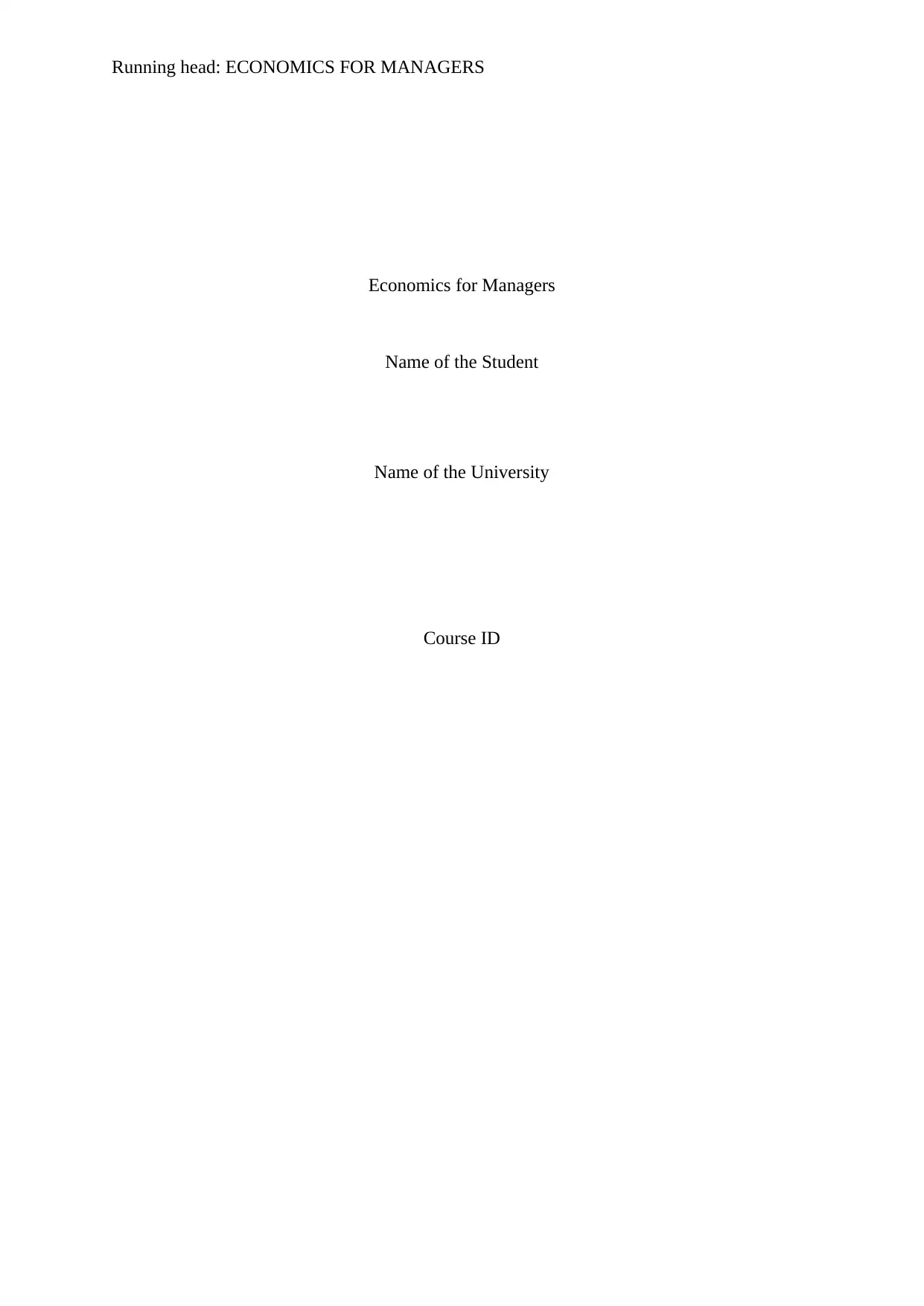
Running head: ECONOMICS FOR MANAGERS
Economics for Managers
Name of the Student
Name of the University
Course ID
Economics for Managers
Name of the Student
Name of the University
Course ID
Paraphrase This Document
Need a fresh take? Get an instant paraphrase of this document with our AI Paraphraser
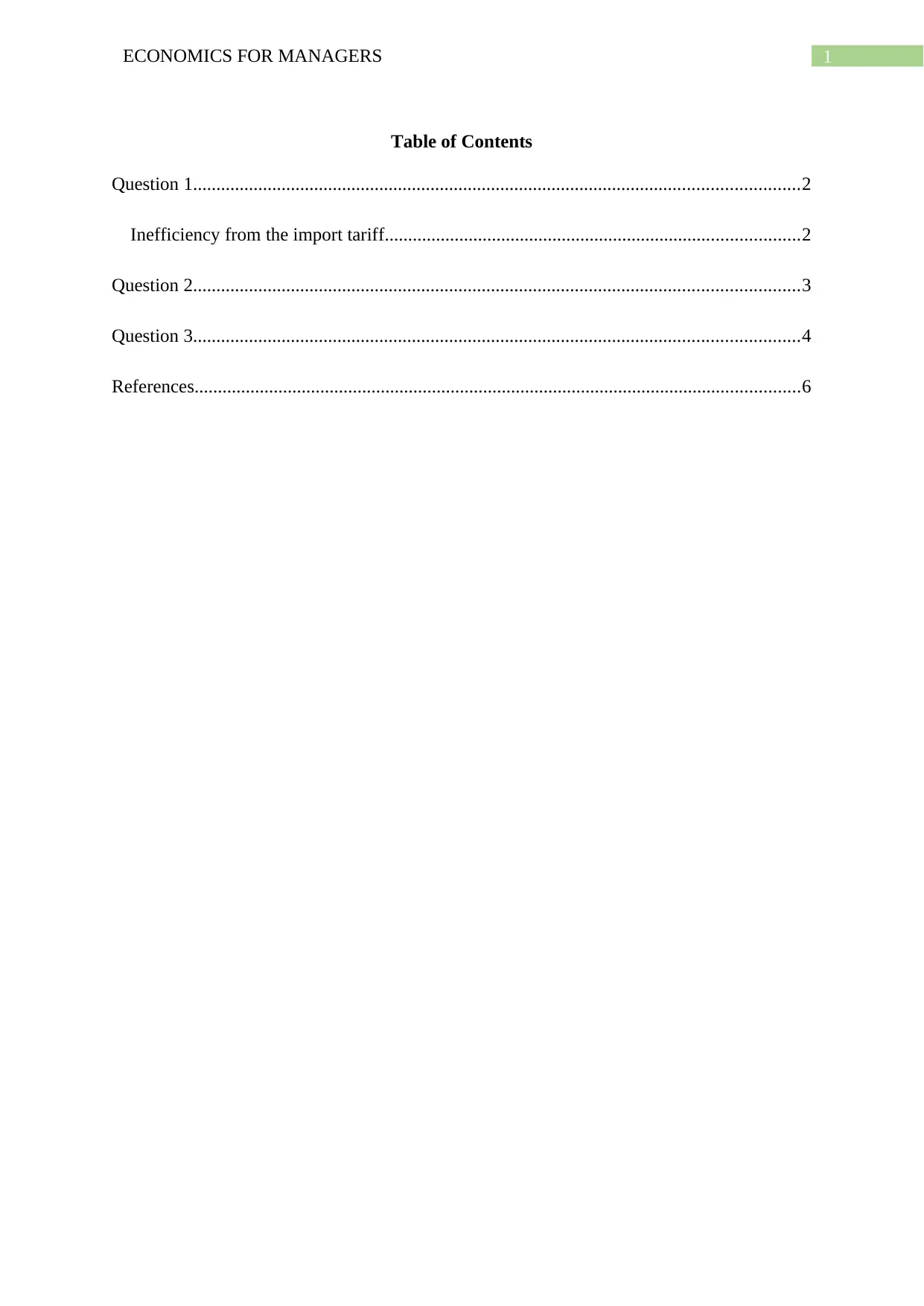
1ECONOMICS FOR MANAGERS
Table of Contents
Question 1..................................................................................................................................2
Inefficiency from the import tariff.........................................................................................2
Question 2..................................................................................................................................3
Question 3..................................................................................................................................4
References..................................................................................................................................6
Table of Contents
Question 1..................................................................................................................................2
Inefficiency from the import tariff.........................................................................................2
Question 2..................................................................................................................................3
Question 3..................................................................................................................................4
References..................................................................................................................................6
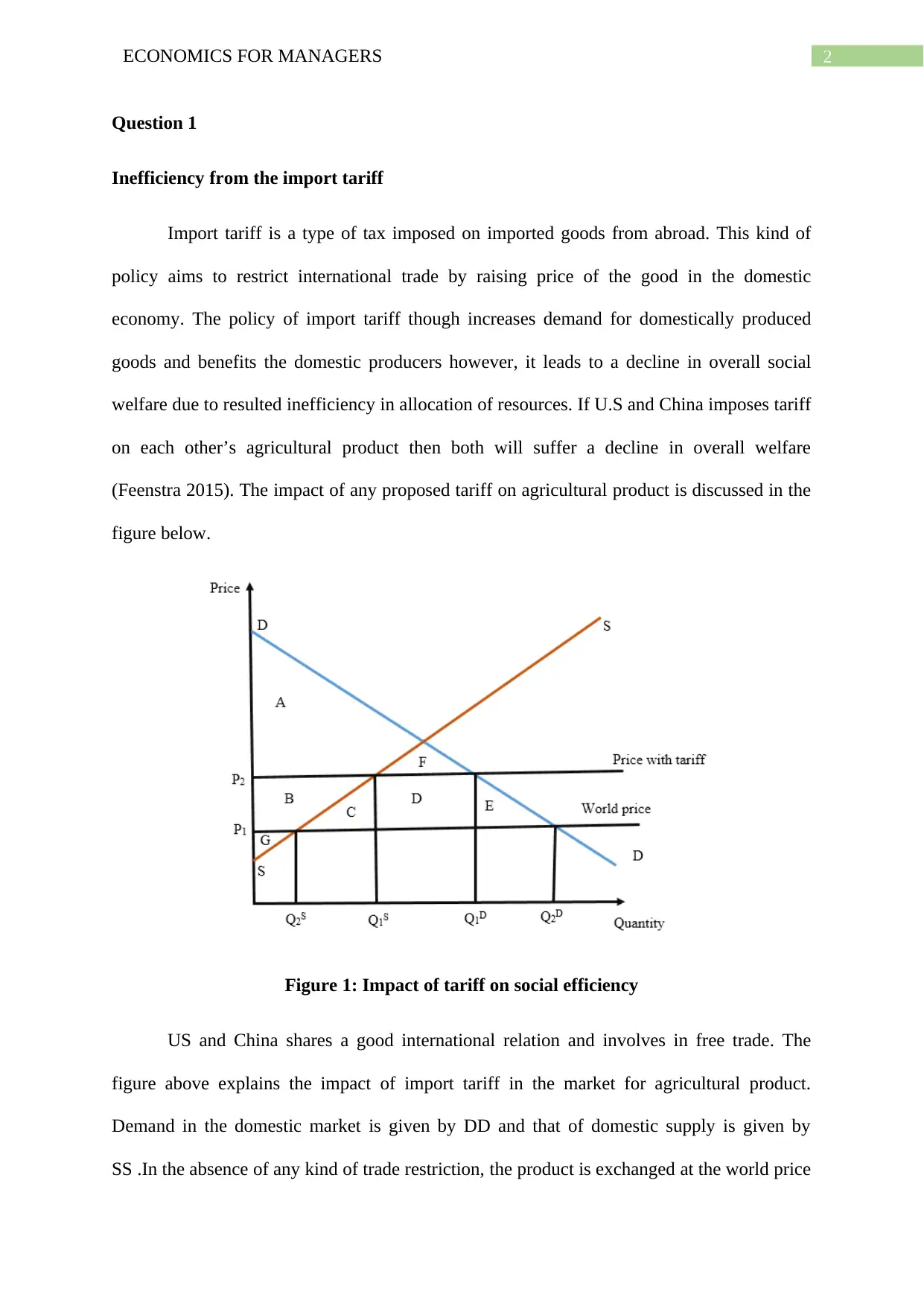
2ECONOMICS FOR MANAGERS
Question 1
Inefficiency from the import tariff
Import tariff is a type of tax imposed on imported goods from abroad. This kind of
policy aims to restrict international trade by raising price of the good in the domestic
economy. The policy of import tariff though increases demand for domestically produced
goods and benefits the domestic producers however, it leads to a decline in overall social
welfare due to resulted inefficiency in allocation of resources. If U.S and China imposes tariff
on each other’s agricultural product then both will suffer a decline in overall welfare
(Feenstra 2015). The impact of any proposed tariff on agricultural product is discussed in the
figure below.
Figure 1: Impact of tariff on social efficiency
US and China shares a good international relation and involves in free trade. The
figure above explains the impact of import tariff in the market for agricultural product.
Demand in the domestic market is given by DD and that of domestic supply is given by
SS .In the absence of any kind of trade restriction, the product is exchanged at the world price
Question 1
Inefficiency from the import tariff
Import tariff is a type of tax imposed on imported goods from abroad. This kind of
policy aims to restrict international trade by raising price of the good in the domestic
economy. The policy of import tariff though increases demand for domestically produced
goods and benefits the domestic producers however, it leads to a decline in overall social
welfare due to resulted inefficiency in allocation of resources. If U.S and China imposes tariff
on each other’s agricultural product then both will suffer a decline in overall welfare
(Feenstra 2015). The impact of any proposed tariff on agricultural product is discussed in the
figure below.
Figure 1: Impact of tariff on social efficiency
US and China shares a good international relation and involves in free trade. The
figure above explains the impact of import tariff in the market for agricultural product.
Demand in the domestic market is given by DD and that of domestic supply is given by
SS .In the absence of any kind of trade restriction, the product is exchanged at the world price
⊘ This is a preview!⊘
Do you want full access?
Subscribe today to unlock all pages.

Trusted by 1+ million students worldwide
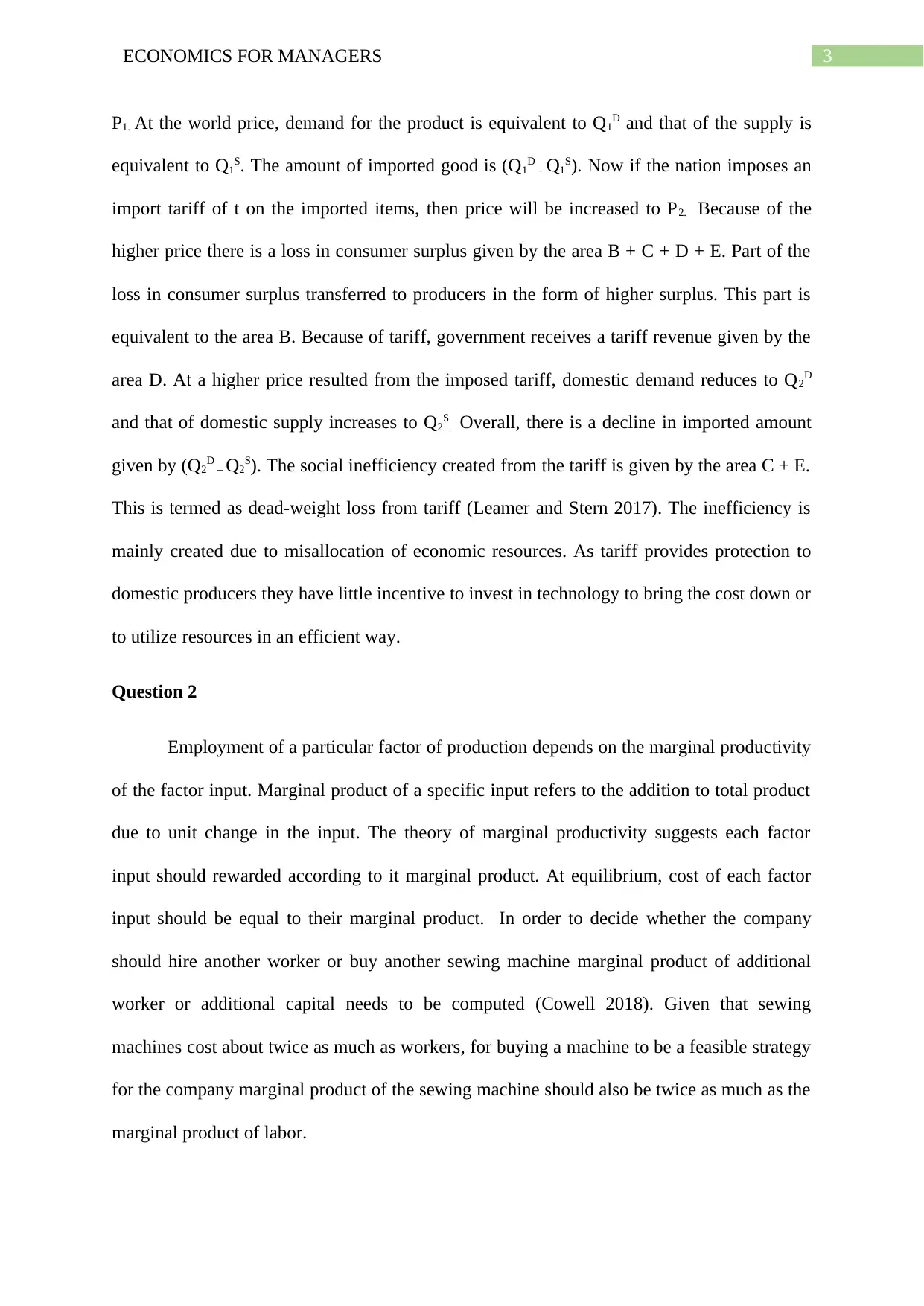
3ECONOMICS FOR MANAGERS
P1. At the world price, demand for the product is equivalent to Q1D and that of the supply is
equivalent to Q1S. The amount of imported good is (Q1D - Q1S). Now if the nation imposes an
import tariff of t on the imported items, then price will be increased to P2. Because of the
higher price there is a loss in consumer surplus given by the area B + C + D + E. Part of the
loss in consumer surplus transferred to producers in the form of higher surplus. This part is
equivalent to the area B. Because of tariff, government receives a tariff revenue given by the
area D. At a higher price resulted from the imposed tariff, domestic demand reduces to Q2D
and that of domestic supply increases to Q2S. Overall, there is a decline in imported amount
given by (Q2D – Q2S). The social inefficiency created from the tariff is given by the area C + E.
This is termed as dead-weight loss from tariff (Leamer and Stern 2017). The inefficiency is
mainly created due to misallocation of economic resources. As tariff provides protection to
domestic producers they have little incentive to invest in technology to bring the cost down or
to utilize resources in an efficient way.
Question 2
Employment of a particular factor of production depends on the marginal productivity
of the factor input. Marginal product of a specific input refers to the addition to total product
due to unit change in the input. The theory of marginal productivity suggests each factor
input should rewarded according to it marginal product. At equilibrium, cost of each factor
input should be equal to their marginal product. In order to decide whether the company
should hire another worker or buy another sewing machine marginal product of additional
worker or additional capital needs to be computed (Cowell 2018). Given that sewing
machines cost about twice as much as workers, for buying a machine to be a feasible strategy
for the company marginal product of the sewing machine should also be twice as much as the
marginal product of labor.
P1. At the world price, demand for the product is equivalent to Q1D and that of the supply is
equivalent to Q1S. The amount of imported good is (Q1D - Q1S). Now if the nation imposes an
import tariff of t on the imported items, then price will be increased to P2. Because of the
higher price there is a loss in consumer surplus given by the area B + C + D + E. Part of the
loss in consumer surplus transferred to producers in the form of higher surplus. This part is
equivalent to the area B. Because of tariff, government receives a tariff revenue given by the
area D. At a higher price resulted from the imposed tariff, domestic demand reduces to Q2D
and that of domestic supply increases to Q2S. Overall, there is a decline in imported amount
given by (Q2D – Q2S). The social inefficiency created from the tariff is given by the area C + E.
This is termed as dead-weight loss from tariff (Leamer and Stern 2017). The inefficiency is
mainly created due to misallocation of economic resources. As tariff provides protection to
domestic producers they have little incentive to invest in technology to bring the cost down or
to utilize resources in an efficient way.
Question 2
Employment of a particular factor of production depends on the marginal productivity
of the factor input. Marginal product of a specific input refers to the addition to total product
due to unit change in the input. The theory of marginal productivity suggests each factor
input should rewarded according to it marginal product. At equilibrium, cost of each factor
input should be equal to their marginal product. In order to decide whether the company
should hire another worker or buy another sewing machine marginal product of additional
worker or additional capital needs to be computed (Cowell 2018). Given that sewing
machines cost about twice as much as workers, for buying a machine to be a feasible strategy
for the company marginal product of the sewing machine should also be twice as much as the
marginal product of labor.
Paraphrase This Document
Need a fresh take? Get an instant paraphrase of this document with our AI Paraphraser
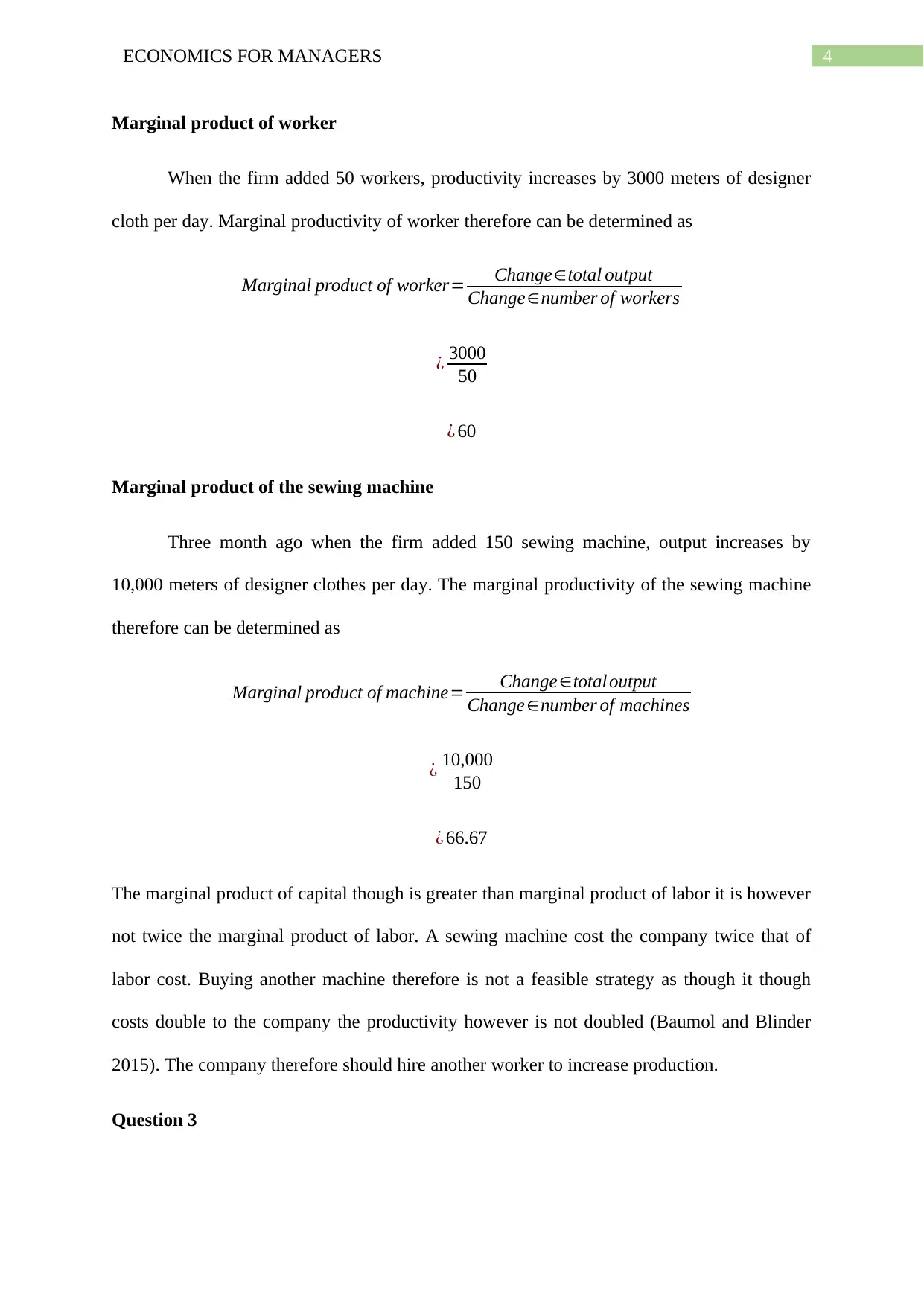
4ECONOMICS FOR MANAGERS
Marginal product of worker
When the firm added 50 workers, productivity increases by 3000 meters of designer
cloth per day. Marginal productivity of worker therefore can be determined as
Marginal product of worker= Change∈total output
Change∈number of workers
¿ 3000
50
¿ 60
Marginal product of the sewing machine
Three month ago when the firm added 150 sewing machine, output increases by
10,000 meters of designer clothes per day. The marginal productivity of the sewing machine
therefore can be determined as
Marginal product of machine= Change∈total output
Change∈number of machines
¿ 10,000
150
¿ 66.67
The marginal product of capital though is greater than marginal product of labor it is however
not twice the marginal product of labor. A sewing machine cost the company twice that of
labor cost. Buying another machine therefore is not a feasible strategy as though it though
costs double to the company the productivity however is not doubled (Baumol and Blinder
2015). The company therefore should hire another worker to increase production.
Question 3
Marginal product of worker
When the firm added 50 workers, productivity increases by 3000 meters of designer
cloth per day. Marginal productivity of worker therefore can be determined as
Marginal product of worker= Change∈total output
Change∈number of workers
¿ 3000
50
¿ 60
Marginal product of the sewing machine
Three month ago when the firm added 150 sewing machine, output increases by
10,000 meters of designer clothes per day. The marginal productivity of the sewing machine
therefore can be determined as
Marginal product of machine= Change∈total output
Change∈number of machines
¿ 10,000
150
¿ 66.67
The marginal product of capital though is greater than marginal product of labor it is however
not twice the marginal product of labor. A sewing machine cost the company twice that of
labor cost. Buying another machine therefore is not a feasible strategy as though it though
costs double to the company the productivity however is not doubled (Baumol and Blinder
2015). The company therefore should hire another worker to increase production.
Question 3
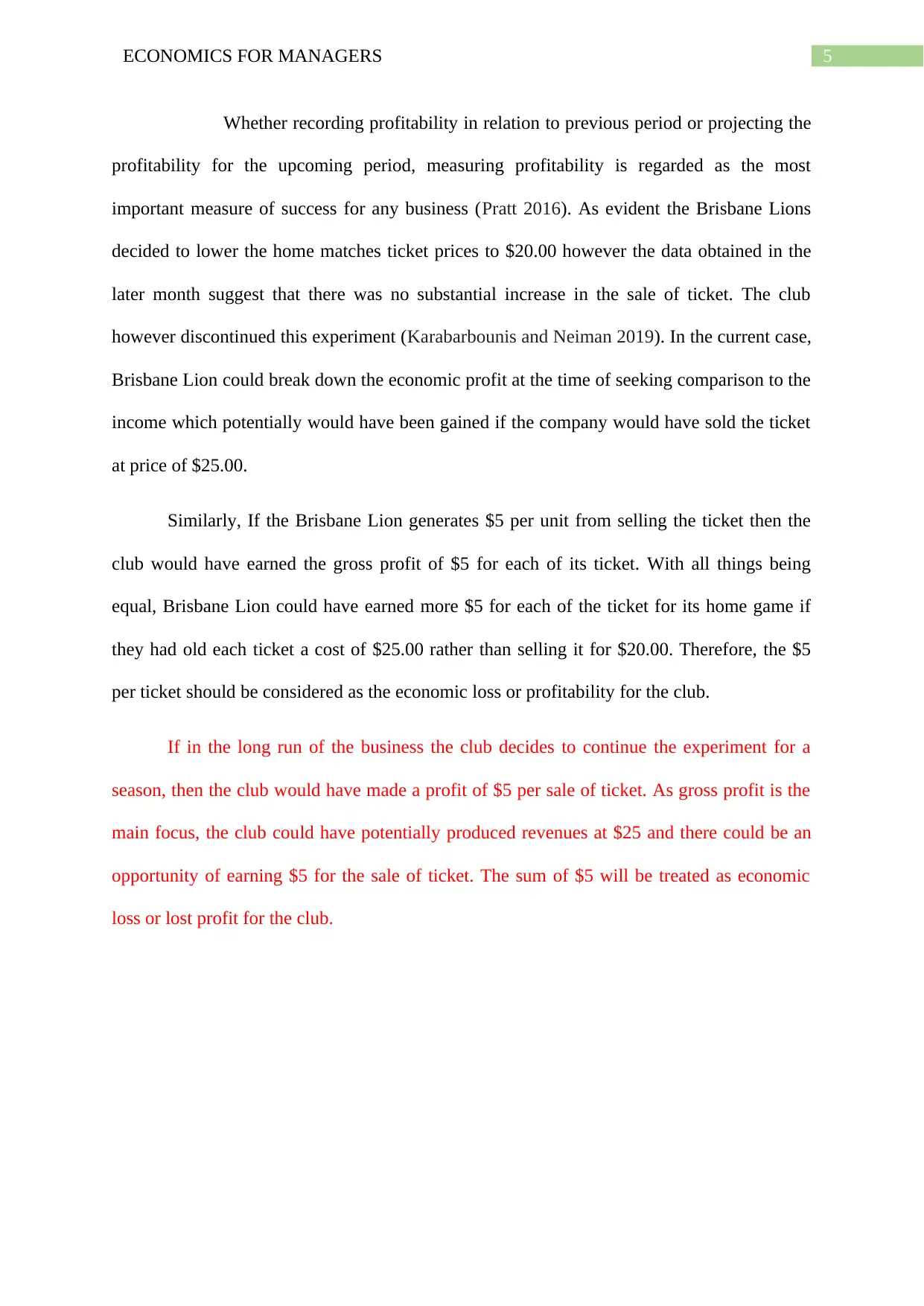
5ECONOMICS FOR MANAGERS
Whether recording profitability in relation to previous period or projecting the
profitability for the upcoming period, measuring profitability is regarded as the most
important measure of success for any business (Pratt 2016). As evident the Brisbane Lions
decided to lower the home matches ticket prices to $20.00 however the data obtained in the
later month suggest that there was no substantial increase in the sale of ticket. The club
however discontinued this experiment (Karabarbounis and Neiman 2019). In the current case,
Brisbane Lion could break down the economic profit at the time of seeking comparison to the
income which potentially would have been gained if the company would have sold the ticket
at price of $25.00.
Similarly, If the Brisbane Lion generates $5 per unit from selling the ticket then the
club would have earned the gross profit of $5 for each of its ticket. With all things being
equal, Brisbane Lion could have earned more $5 for each of the ticket for its home game if
they had old each ticket a cost of $25.00 rather than selling it for $20.00. Therefore, the $5
per ticket should be considered as the economic loss or profitability for the club.
If in the long run of the business the club decides to continue the experiment for a
season, then the club would have made a profit of $5 per sale of ticket. As gross profit is the
main focus, the club could have potentially produced revenues at $25 and there could be an
opportunity of earning $5 for the sale of ticket. The sum of $5 will be treated as economic
loss or lost profit for the club.
Whether recording profitability in relation to previous period or projecting the
profitability for the upcoming period, measuring profitability is regarded as the most
important measure of success for any business (Pratt 2016). As evident the Brisbane Lions
decided to lower the home matches ticket prices to $20.00 however the data obtained in the
later month suggest that there was no substantial increase in the sale of ticket. The club
however discontinued this experiment (Karabarbounis and Neiman 2019). In the current case,
Brisbane Lion could break down the economic profit at the time of seeking comparison to the
income which potentially would have been gained if the company would have sold the ticket
at price of $25.00.
Similarly, If the Brisbane Lion generates $5 per unit from selling the ticket then the
club would have earned the gross profit of $5 for each of its ticket. With all things being
equal, Brisbane Lion could have earned more $5 for each of the ticket for its home game if
they had old each ticket a cost of $25.00 rather than selling it for $20.00. Therefore, the $5
per ticket should be considered as the economic loss or profitability for the club.
If in the long run of the business the club decides to continue the experiment for a
season, then the club would have made a profit of $5 per sale of ticket. As gross profit is the
main focus, the club could have potentially produced revenues at $25 and there could be an
opportunity of earning $5 for the sale of ticket. The sum of $5 will be treated as economic
loss or lost profit for the club.
⊘ This is a preview!⊘
Do you want full access?
Subscribe today to unlock all pages.

Trusted by 1+ million students worldwide
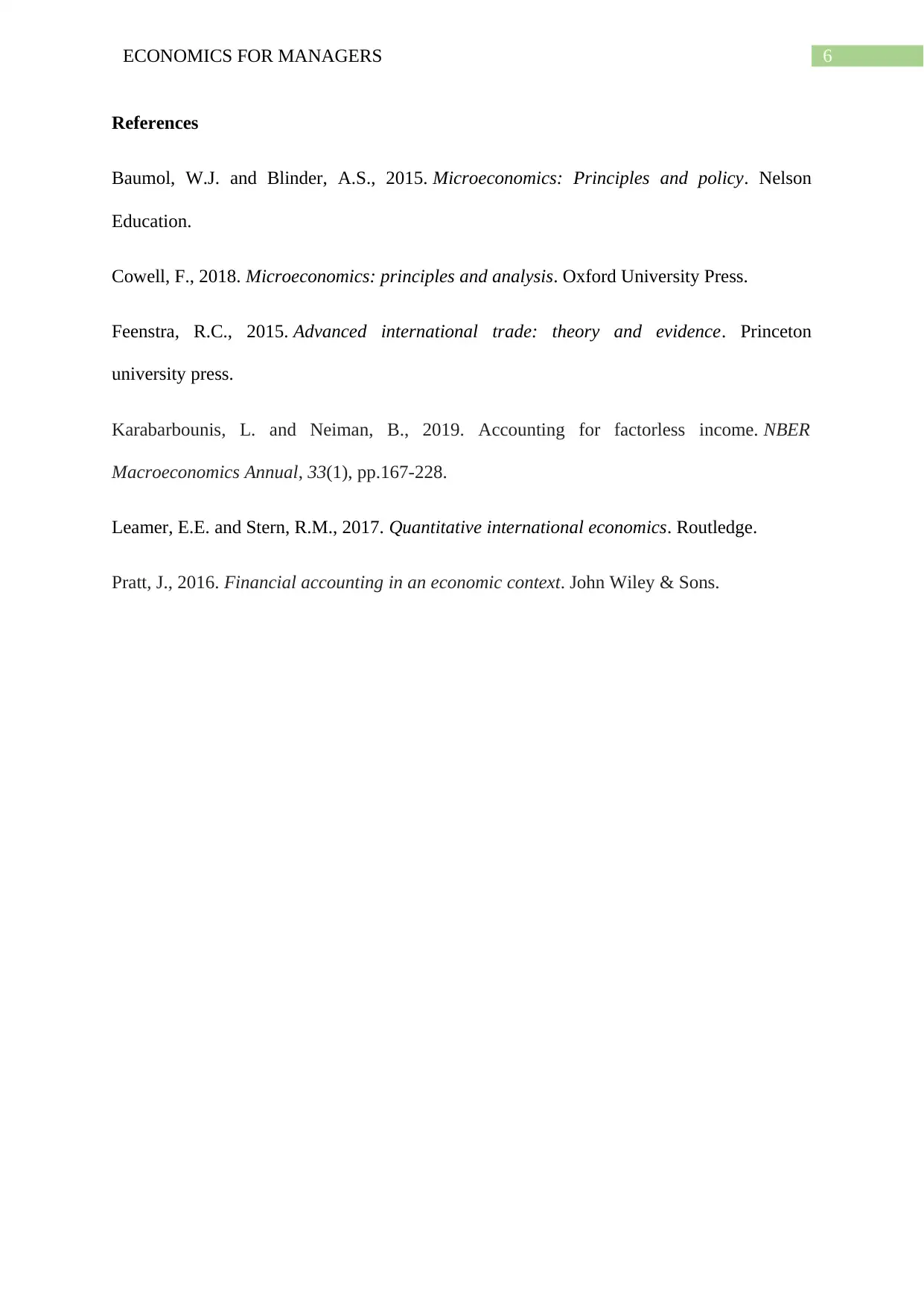
6ECONOMICS FOR MANAGERS
References
Baumol, W.J. and Blinder, A.S., 2015. Microeconomics: Principles and policy. Nelson
Education.
Cowell, F., 2018. Microeconomics: principles and analysis. Oxford University Press.
Feenstra, R.C., 2015. Advanced international trade: theory and evidence. Princeton
university press.
Karabarbounis, L. and Neiman, B., 2019. Accounting for factorless income. NBER
Macroeconomics Annual, 33(1), pp.167-228.
Leamer, E.E. and Stern, R.M., 2017. Quantitative international economics. Routledge.
Pratt, J., 2016. Financial accounting in an economic context. John Wiley & Sons.
References
Baumol, W.J. and Blinder, A.S., 2015. Microeconomics: Principles and policy. Nelson
Education.
Cowell, F., 2018. Microeconomics: principles and analysis. Oxford University Press.
Feenstra, R.C., 2015. Advanced international trade: theory and evidence. Princeton
university press.
Karabarbounis, L. and Neiman, B., 2019. Accounting for factorless income. NBER
Macroeconomics Annual, 33(1), pp.167-228.
Leamer, E.E. and Stern, R.M., 2017. Quantitative international economics. Routledge.
Pratt, J., 2016. Financial accounting in an economic context. John Wiley & Sons.
1 out of 7
Related Documents
Your All-in-One AI-Powered Toolkit for Academic Success.
+13062052269
info@desklib.com
Available 24*7 on WhatsApp / Email
![[object Object]](/_next/static/media/star-bottom.7253800d.svg)
Unlock your academic potential
Copyright © 2020–2025 A2Z Services. All Rights Reserved. Developed and managed by ZUCOL.





